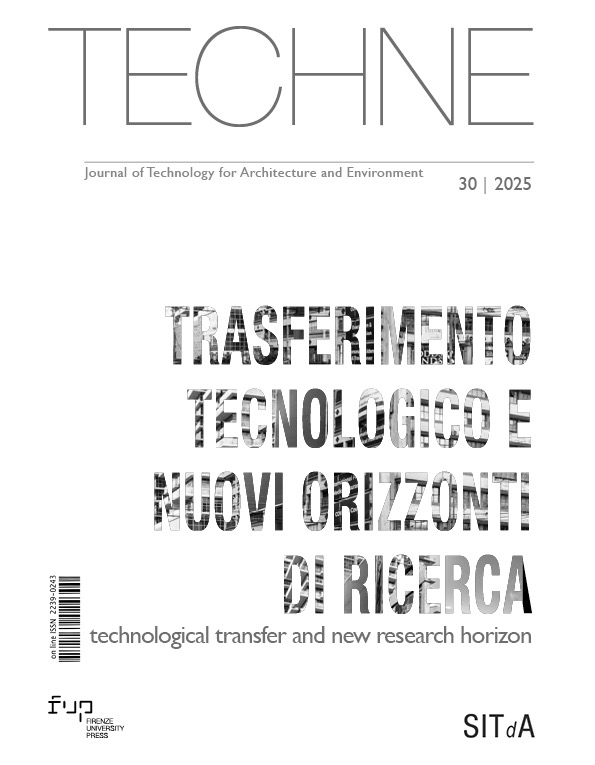Published 2025-11-07
Keywords
- Technological transfer,
- Bio-based materials,
- Participatory process,
- Multi-criteria analysis
How to Cite
Copyright (c) 2025 Fernanda Speciale, Laura Elisabetta Malighetti, Hector Archila Santos

This work is licensed under a Creative Commons Attribution 4.0 International License.
Abstract
This paper explores the process of interaction among various stakeholders within the SmartBioC project, developed by UWE (Bristol) in collaboration with the Politecnico di Milano, as an example of technology transfer to promote the use of bio-based materials in sustainable construction. Through a participatory approach, the project engaged over 50 stakeholders through interactive workshops and gamification tools, including academics, professionals, construction entrepreneurs, policymakers, and end users. The results highlight increased awareness, new networks between research and industry, and innovative decision-making tools, contributing to the objectives of knowledge transfer and Third Mission.
Downloads
References
- Boelen, J., Dos Reis Martins, M. and Dumoncel d’Argence, C. (2023), Bioregional Design Practices, Atelier Luma, available at: https://books.google.it/books?id=_3cD0AEACAAJ (Accessed on 14/05/2025).
- Bornmann, L. (2013), “What is societal impact of research and how can it be assessed? A literature survey”, Journal of the American Society for Information Science and Technology, Vol. 64, n. 2, pp. 217-233, available at: https://doi.org/10.1002/asi.22803. DOI: https://doi.org/10.1002/asi.22803
- Claudi De Saint Mihiel, A. (2024), “Open innovation for the competitiveness of the construction sector”, TECHNE – Journal of Technology for Architecture and Environment, (28), pp. 317–323, available at: https://doi.org/10.36253/techne-16564. DOI: https://doi.org/10.36253/techne-16564
- Claudi De Saint Mihiel, A. (2019), “The Third Mission between the innovative dimension and the public engagement function”, TECHNE – Journal of Technology for Architecture and Environment, (18), pp. 341-344, available at: https://doi.org/10.13128/TECHNE-7550.
- Göswein, V., Arehart, J., Phan-huy, C., Pomponi, F. and Habert, G. (2022), “Barriers and opportunities of fast-growing biobased material use in buildings”, Buildings and Cities, Vol. 3, n. 1, pp. 745-755, available at: https://doi.org/10.5334/bc.254. DOI: https://doi.org/10.5334/bc.254
- Greco, S., Ehrgott, M. and Figueira, J.R. (Eds.) (2016), Multiple Criteria Decision Analysis: State of the Art Surveys, International Series in Operations Research & Management Science, Springer, New York, NY, available at: https://doi.org/10.1007/978-1-4939-3094-4. DOI: https://doi.org/10.1007/978-1-4939-3094-4
- Kapp, K.M. (2012), The Gamification of Learning and Instruction: Game-based Methods and Strategies for Training and Education, Pfeiffer, San Francisco, CA. DOI: https://doi.org/10.1145/2207270.2211316
- Koster, M. and Schrotenboer, I. (2022), “Successful circular bio-based construction initiatives: five essentials from case studies”, Construction Technologies and Architecture, Vol. 1, pp. 448-457, available at: https://doi.org/10.4028/www.scientific.net/CTA.1.448. DOI: https://doi.org/10.4028/www.scientific.net/CTA.1.448
- Losasso, M. (2014), “Research, architectural design and knowledge transfer”, TECHNE – Journal of Technology for Architecture and Environment, (8), pp. 8-12, available at: https://doi.org/10.13128/TECHNE-15050.
- Passer, A., Habert, G., Kromp-Kolb, H., Lützkendorf, T. and Monsberger, M. (2019), “Transition Towards a Net Zero Carbon Built Environment”, International Journal of Life Cycle Assessment, Vol. 24, n. 2, pp. 362-363, available at: https://doi.org/10.1007/s11367-018-1550-9. DOI: https://doi.org/10.1007/s11367-018-1550-9
- Porritt, J. (2012), Capitalism: As If the World Matters, Earthscan, London, p. 360, available at: https://doi.org/10.4324/9781849770668. DOI: https://doi.org/10.4324/9781849770668
- Rabbat, C., Awad, S., Villot, A., Rollet, D. and Andrès, Y. (2022), “Sustainability of biomass-based insulation materials in buildings: Current status in France, end-of-life projections and energy recovery potentials”, Renewable and Sustainable Energy Reviews, Vol. 156, p. 111962, available at: https://doi.org/10.1016/j.rser.2021.111962. DOI: https://doi.org/10.1016/j.rser.2021.111962
- Röck, M., Saade, M.R.M., Balouktsi, M., Rasmussen, F.N., Birgisdottir, H., Frischknecht, R., Habert, G., Lützkendorf, T. and Passer, A. (2020), “Embodied GHG emissions of buildings – The hidden challenge for effective climate change mitigation”, Applied Energy, Vol. 258, p. 114107, available at: https://doi.org/10.1016/j.apenergy.2019.114107. DOI: https://doi.org/10.1016/j.apenergy.2019.114107
- UN Environment and International Energy Agency (2018), Towards a Zero-Emission, Efficient, and Resilient Buildings and Construction Sector. Global Status Report 2017, available at: https://globalabc.org/index.php/resources/publications/2017-global-status-report-buildings-and-construction (Accessed on 14/05/2025).
- United Nations Environment Programme, I.R.P. (2019), Global Resources Outlook 2019: Natural Resources for the Future We Want, available at: https://wedocs.unep.org/20.500.11822/27517 (Accessed on 14/05/2025).
- Vrins, M. (2018), Standards and Regulations for the Bio-based Industry STAR4BBI – Report on Implementation for Creation of New or Revised Standards, available at: https://www.star4bbi.eu/app/uploads/sites/11/2019/09/D3.3-Sustainability-Certification-for-all-Products_final.pdf (Accessed on 14/05/2025).
- Weiss, M., Haufe, J., Carus, M., Brandão, M., Bringezu, S., Hermann, B. and Patel, M.K. (2012), “A Review of the Environmental Impacts of Biobased Materials”, Journal of Industrial Ecology, Vol. 16, Suppl. 1, pp. S169–S181, available at: https://doi.org/10.1111/j.1530-9290.2012.00468.x. DOI: https://doi.org/10.1111/j.1530-9290.2012.00468.x






